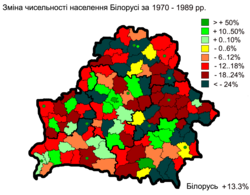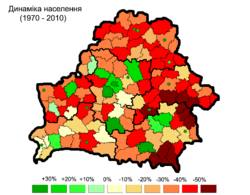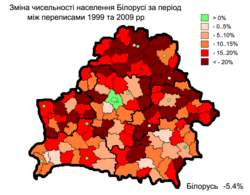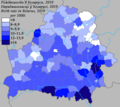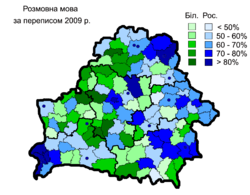| Demographics of Belarus | |
|---|---|
 Population pyramid of Belarus in 2023 | |
| Population | 9,109,280 (2025) [1] |
| Fertility rate | |
| Age structure | |
| 0–14 years | 16.9% (male 821,285/female 772,360) |
| 15–64 years | 67.7% (male 3,053,618/female 3,314,835) |
| 65 and over | 15.4% (male 479,740/female 971,608) (2019 census) |
| Sex ratio | |
| Total | 0.87 male(s)/female (2014) |
| At birth | 1.06 male(s)/female |
| Under 15 | 1.06 male(s)/female |
| 15–64 years | 0.94 male(s)/female |
| 65 and over | 0.46 male(s)/female |
| Nationality | |
| Nationality | noun: Belarusian(s) adjective: Belarusian |
| Major ethnic | Belarusians |
| Minor ethnic | Russians, Poles |
| Language | |
| Spoken | Russian, Belarusian |
| Year | Pop. | ±% p.a. |
|---|---|---|
| 1897 | 6,493,600 | — |
| 1914 | 8,961,800 | +1.91% |
| 1926 | 4,983,240 | −4.77% |
| 1937 | 5,196,549 | +0.38% |
| 1940 | 10,400,000 [a] | +26.02% |
| 1951 | 7,781,100 | −2.60% |
| 1959 | 8,055,700 | +0.43% |
| 1970 | 8,992,200 | +1.00% |
| 1979 | 9,532,500 | +0.65% |
| 1989 | 10,151,800 | +0.63% |
| 1999 | 10,045,200 | −0.11% |
| 2009 | 9,503,800 | −0.55% |
| 2019 | 9,413,446 | −0.10% |
| 2021 | 9,349,645 | −0.34% |
| 2025 | 9,109,280 | −0.65% |
| Source: [3] [4] [b] [5] [6] [7] < [8] | ||
The demographics of Belarus is about the demographic features of the population of Belarus, including population growth, population density, ethnicity, education level, health, economic status, religious affiliations, and other aspects of the population.
Contents
- Population
- Population 2
- Age structure
- Median age
- Sex ratio
- Life expectancy at birth
- Total fertility rate (TFR) in Belarus by region and year
- Infant mortality rate
- Vital statistics
- Belarusian provinces of the Russian Empire
- After WW2
- Current vital statistics
- Structure of the population
- Migration
- Ethnic groups
- Prior to the Second World War
- After the Second World War
- Languages
- Religion
- Urbanization
- Notes
- See also
- References
- External links
